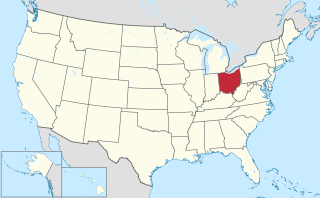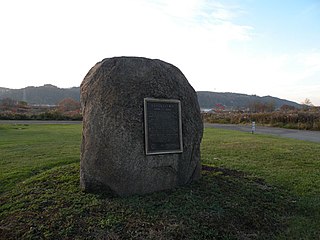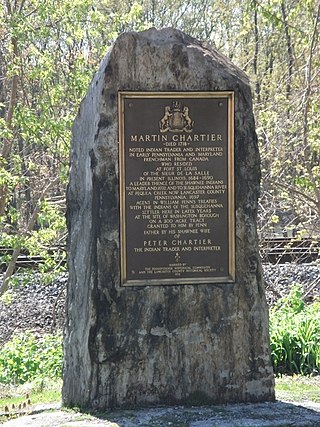Related Research Articles

Kittanning was an 18th-century Native American village in the Ohio Country, located on the Allegheny River at present-day Kittanning, Pennsylvania. The village was at the western terminus of the Kittanning Path, an Indian trail that provided a route across the Alleghenies between the Ohio and Susquehanna river basins.

The Treaty of Fort Stanwix was a treaty signed between representatives from the Iroquois and Great Britain in 1768 at Fort Stanwix. It was negotiated between Sir William Johnson, his deputy George Croghan, and representatives of the Iroquois.
George Croghan was an Irish-born fur trader in the Ohio Country of North America who became a key early figure in the region. In 1746 he was appointed to the Onondaga Council, the governing body of the Iroquois, and remained so until he was banished from the frontier in 1777 during the American Revolutionary War. Emigrating from Ireland to Pennsylvania in 1741, he had become an important trader by going to the villages of Indigenous Peoples, learning their languages and customs, and working on the frontier where previously mostly French had been trading. During and after King George's War of the 1740s, he helped negotiate new treaties and alliances for the British with Native Americans.

Shamokin was a multi-ethnic Native American trading village on the Susquehanna River, located partially within the limits of the modern cities of Sunbury and Shamokin Dam, Pennsylvania. It should not be confused with present-day Shamokin, Pennsylvania, located to the east. The village was the focus of missionary efforts, and then was the staging area for raids on English settlements in Pennsylvania during the French and Indian War. It was burned and abandoned by the Lenape in May, 1756. A few months later, Fort Augusta was constructed on the site of the village.

Pickawillany was an 18th-century Miami Indian village located on the Great Miami River in North America's Ohio Valley near the modern city of Piqua, Ohio. In 1749 an English trading post was established alongside the Miami village, selling goods to neighboring tribes at the site. In 1750, a stockade was constructed to protect the post. French and English colonists were competing for control of the fur trade in the Ohio Country as part of their overall struggle for dominance in North America. In less than five years, Pickawillany grew to be one of the largest Native American communities in eastern North America.

The riverside village of Logstown also known as Logg's Town, French: Chiningue near modern-day Baden, Pennsylvania, was a significant Native American settlement in Western Pennsylvania and the site of the 1752 signing of the Treaty of Logstown between the Ohio Company, the Colony of Virginia, and the Six Nations, which occupied the region. Being an unusually large settlement, and because of its strategic location in the Ohio Country, an area contested by France and England, Logstown was an important community for all parties living along the Ohio and tributary rivers. Logstown was a prominent trade and council site for the contending British and French colonial governments, both of which made abortive plans to construct forts near the town. Logstown was burned in 1754 and although it was rebuilt, in the years following the French and Indian War it became depopulated and was eventually abandoned.
Pierre-Joseph Céloron de Blainville — also known as Celeron de Bienville — was a French Canadian Officer of Marine. In 1739 and '40 he led a detachment to Louisiana to fight the Chickasaw in the abortive Chickasaw Campaign of 1739. In 1749 he led the 'Lead Plate Expedition' to advance France's territorial claim on the Ohio Valley.

Lower Shawneetown, also known as Shannoah or Sonnontio, was an 18th-century Shawnee village located within the Lower Shawneetown Archeological District, near South Portsmouth in Greenup County, Kentucky and Lewis County, Kentucky. The population eventually occupied areas on both sides of the Ohio River, and along both sides of the Scioto River in what is now Scioto County, Ohio. It was added to the National Register of Historic Places on 28 April 1983. It is near the Bentley site, a Madisonville Horizon settlement inhabited between 1400 CE and 1625 CE. Nearby, to the east, there are also four groups of Hopewell tradition mounds, built between 100 BCE and 500 CE, known as the Portsmouth Earthworks.

The Conrad Weiser Homestead was the home of Johann Conrad Weiser, who enlisted the Iroquois on the British side in the French and Indian War. The home is located near Womelsdorf, Berks County, Pennsylvania in the United States. A designated National Historic Landmark, it is currently administered as a historic house museum by the Pennsylvania Historical and Museum Commission. The historic site was established in 1923 to preserve an example of a colonial homestead and to honor Weiser, an important figure in the settlement of the colonial frontier.

Conrad Weiser, born Johann Conrad Weiser, Jr., was a Pennsylvania Dutch (German) pioneer who served as an interpreter and diplomat between the Pennsylvania Colony and Native American nations. Primarily a farmer, he also worked as a tanner, and later served as a soldier and judge. He lived part of the time for six years at Ephrata Cloister, a Protestant monastic community in Lancaster County.
Peter Chartier (1690—c.1759) was a fur trader of mixed Shawnee and French parentage. Multilingual, he later became a leader and a band chief among the Pekowi Shawnee. As an early advocate for Native American civil rights, he joined other chiefs in opposing the sale and trade of alcohol in indigenous communities in the Province of Pennsylvania. He first tried to limit the sale of rum in Shawnee communities but expanded that effort to other indigenous peoples.

Martin Chartier was a French-Canadian explorer and trader, carpenter and glove maker. He lived much of his life amongst the Shawnee Native Americans in what is now the United States.
Meshemethequater also known as Big Hominy, Great Huminy, Misemeathaquatha, Missemediqueety, or Big Hannoana was a Pekowi Shawnee chief from western Pennsylvania. Although he was a respected warrior, he is best known for participating in peace conferences that prevented war between English settlers and the Shawnees. In 1745 he joined Peter Chartier and other Shawnees who chose loyalty to New France, but after three years he returned to Pennsylvania and apologized. His date and place of death are unknown.
Opessa Straight Tail, also known as Wopatha or Wapatha, was a Pekowi Shawnee Chief. He was the son of Straight Tail Meaurroway Opessa. He is best known for signing, on 23 April 1701, the "Articles of friendship and agreement between William Penn and the Susquehannah, Shawonah, and North Patomack Indians," that designated lands and conditions of coexistence between those tribes and the English settlers.
Neucheconeh was a Pekowi Shawnee chief from western Pennsylvania. From 1732 to 1745, Neucheconeh shared leadership of the Shawnee of western Pennsylvania with Kakowatcheky. During that time, he petitioned the Pennsylvania Provincial Government to regulate the sale of alcohol in Shawnee communities and was involved in the migration of many Shawnees into the Ohio River Valley, away from the influence of European settlers and into a region where game was more plentiful. In 1745 he joined Peter Chartier and other Shawnees who chose loyalty to New France, but after three years he returned to Pennsylvania and apologized. His date and place of death are unknown.

Kuskusky, also known as the Kuskuskies Towns, Kuskuskie Towns, or Kuskuskies' Indian Town, with a wide variety of other spellings, were several Native American communities inhabited near New Castle, Mahoning, and Edinburg, Pennsylvania, and Youngstown, Ohio, during the mid-18th century. It was not one town, but three or four contiguous towns of the Mingoes, Lenape, and Seneca, located along the Beaver River, at and above the junction of its east and west branches, the Mahoning River and the Shenango River. It is usually referred to in the plural.
James Le Tort was a Pennsylvania fur trader and a coureur des bois active in the early 18th century. He established trading posts at several remote Native American communities in Pennsylvania and Ohio and became fluent in the Delaware and Shawnee languages. During the 1720s he frequently served as an interpreter at councils and conferences between Native American leaders and the government of the Province of Pennsylvania.
Sassoonan or Allumapees was a Lenape chief who lived in the colonial-era Province of Pennsylvania in the late 17th and early 18th century. He was known for his negotiations with the provincial government of Pennsylvania in several land purchases. He was a respected leader until political intrigue and migration of the Lenape into the Ohio Country diminished his influence. During his final years he became dependent on alcohol and died in Shamokin in 1747. After his death the Lenape were without a chief until 1752, when the Iroquois half-king Tanacharison appointed Shingas to represent them at the Logstown Treaty conference. He was a son of Tamanend, also known as "Tammany," a well-respected Lenape sachem known as a lover of peace and friendship.

Tamaqua or Tamaque, also known as The Beaver and King Beaver, was a leading man of the Unalachtigo (Turkey) phratry of the Lenape people. Although the Iroquois in 1752 had appointed Shingas chief of the Lenape at the Treaty of Logstown, after the French and Indian War Tamaqua rose in prominence through his active role as peace negotiator, and was acknowledged by many Lenape as their "king" or chief spokesman. He was among the first to hand over English captives at the end of the French and Indian War and was active in peace negotiations at the conclusion of Pontiac's War. By 1758, he was recognized as one of three principal leaders of the Lenape, being the primary spokesman for the western Lenape in the Ohio Country. He founded the town of Tuscarawas, Ohio, in 1756 and died there in 1769 or 1771.

Shannopin's Town, or Shannopintown, was an 18th-century Lenape (Delaware) town located within the site of modern-day Pittsburgh, Pennsylvania, along the Allegheny River, approximately two miles east from its junction with the Monongahela River. In the early 1700s, British colonial settlers began spreading into western Pennsylvania, forcing Lenape and other American Indian tribes to move further west, settling in the Ohio Country. Shannopin's Town was one of several communities established in western Pennsylvania in the 1720s. The town was largely abandoned during the construction of Fort Duquesne in 1754, although a small community still existed when General John Forbes' troops arrived in September 1758. The community was gone by the time construction on Fort Pitt was started in 1759.
References
- 1 2 3 4 5 6 7 8 9 Charles Augustus Hanna, The Wilderness Trail: Or, The Ventures and Adventures of the Pennsylvania Traders on the Allegheny Path, Volume 1, Putnam's sons, 1911
- 1 2 John Heckewelder, History, Manners, and Customs of The Indian Nations who once Inhabited Pennsylvania and the Neighbouring States, Philadelphia: Historical Society of Pennsylvania, 1881.
- ↑ Helen Broshar, "The First Push Westward of the Albany Traders," The Mississippi Valley Historical Review, Vol. 7, No. 3 (Dec., 1920), pp. 228-241
- ↑ Stephen Warren, Worlds the Shawnees Made: Migration and Violence in Early America, UNC Press Books, 2014 ISBN 1469611732
- ↑ Eshleman, Henry Frank, Lancaster County Indians; annals of the Susquehannocks and other Indian tribes of the Susquehanna territory from about the year 1500 to 1763, the date of their extinction, Pennsylvania Historical Society, 1909
- 1 2 Charles Augustus Hanna, The Wilderness Trail: Or, The Ventures and Adventures of the Pennsylvania Traders on the Allegheny Path, Volume 2, Putnam's sons, 1911
- ↑ Bowden, James, The history of the Society of Friends in America, Toronto: London C. Giplin, 1850
- 1 2 George P. Donehoo, "The Shawnee in Pennsylvania," Western Pennsylvania Historical Magazine, vol 7, No 3:178-87; January, 1924; Western Pennsylvania Historical Society
- 1 2 Wallace, Paul A. W. Indians in Pennsylvania. DIANE Publishing Company, 2007. ISBN 1422314936
- 1 2 3 4 5 6 7 Chester Hale Sipe, The Indian chiefs of Pennsylvania, or, A story of the part played by the American Indian in the history of Pennsylvania: based primarily on the Pennsylvania archives and colonial records, and built around the outstanding chiefs, Butler, Pa.: Ziegler Print. Co., Inc., 1927
- ↑ Samuel Hazard, ed. Pennsylvania Archives, vol 1, commencing 1644. Philadelphia: Joseph Severns & Co., 1852.
- 1 2 Samuel Hazard, ed. Minutes of the Provincial Council of Pennsylvania, vol 3, 1717-1735; Harrisburg, Theophilus Fenn. J.Severns, 1840.
- ↑ Graf von Zinzendorf, Nicolaus Ludwig., Mack, John Martin. Memorials of the Moravian Church, William C. Reichel, ed. Philadelphia: J.B. Lippencott and Company, 1870
- 1 2 Malcolm B. Brown, ""God Was Better Pleased with the Indians:" The Shawnee Sachem Kakowatcheky and Moravian Missionary Efforts in the Susquehanna Valley," in "Native Americans: Cultural Encounters," American Studies Journal, Number 46, Winter 2000, pp. 13-20
- ↑ Walton, Joseph Solomon. Conrad Weiser and the Indian Policy of Colonial Pennsylvania. George W. Jacobs & Company, 1900.
- ↑ C. Hale Sipe, "The Principal Indian Towns of Western Pennsylvania," Western Pennsylvania Historical Magazine, v. 13, no. 2; April 1, 1930; pp. 104-122
- ↑ Doug MacGregor, "The Shot Not Heard Around the World: Trent's Fort and the Opening of the War for Empire." Pennsylvania History: A Journal of Mid-Atlantic Studies, Summer 2007, Vol. 74, No. 3, State College: Penn State University Press pp. 354-373
- ↑ O. H. Marshall, "De Celoron's Expedition to the Ohio in 1749, Magazine of American History, March, 1878, p. 146.
- ↑ Malcolm B. Brown, "Is It Not Our Land?" An Ethnohistory of the Susquehanna-Ohio Indian Alliance, 1701-1754," Ph. D. thesis, University of Oklahoma, December 1996
- ↑ Colonial Records: Minutes of the Provincial Council of Pennsylvania from the organization to the termination of the proprietary government. v. 11-16 Minutes of the Supreme Executive Council of Pennsylvania from its organization to the termination of the revolution, 1745-1754. Harrisburg: Theo. Fenn & Company, 1851.
- ↑ Mulkearn, Lois. George Mercer Papers: Relating to the Ohio Company of Virginia. University of Pittsburgh Press, 1954.
- ↑ Paul A.W. Wallace, Indians in Pennsylvania Pennsylvania Historical and Museum Commission, Harrisburg, PA 1961